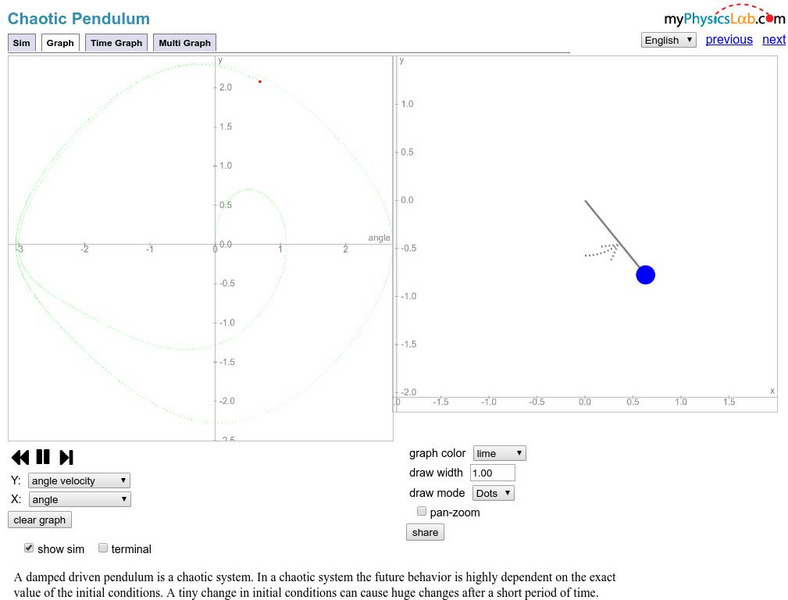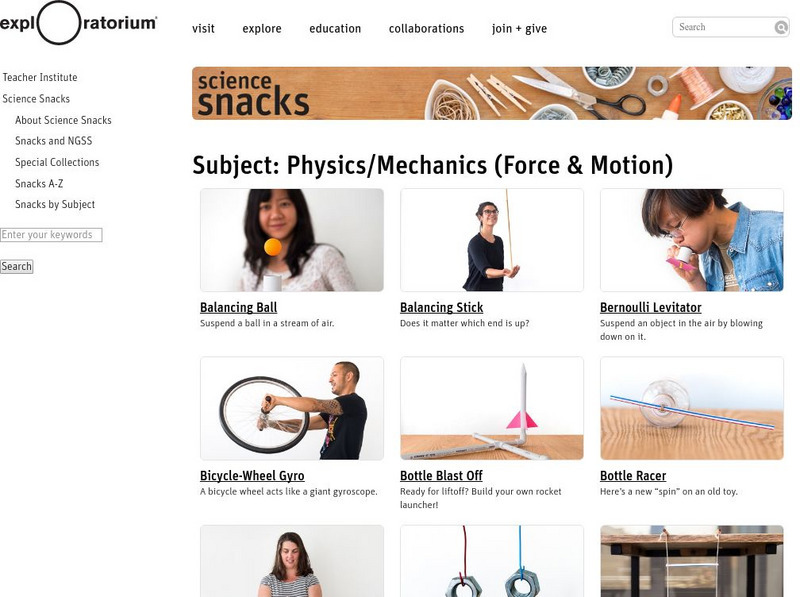Hi, what do you want to do?
Curated OER
Waves Interference
Students identify different wave types and their characteristics. For this wave lesson students complete activities by activating tuning forks and interpreting data.
Curated OER
Good Vibrations: Building a Wave Model
Students assess and apply recurring patterns in natural systems. They evaluate the wave properties of frequency, wavelength, and speed as applied to sound. Students develop a relationship to quantify aspects of wave motion. They predict...
Curated OER
Acceleration and You
Pupils discuss and view examples of acceleration. They work together to determine acceleration rates in two ways. They analyze their data and discuss.
Curated OER
Unknown Element Project
Students work with a partner to determine the identity of an unknown element based on given descriptions. Groups use classroom textbooks, encyclopedias, and science internet sites to identify their unknown element then write a report as...
Science Education Resource Center at Carleton College
Serc: Investigating Calculating the Effect of Mass, Length and Displacement
In this physics lab activity students investigate how mass, length and angular displacement affect the period of a simple pendulum. Students control variables, testing one variable at a time, using manual techniques (stopwatch, human...
Science Education Resource Center at Carleton College
Serc: Period of a Pendulum Investigation
Using a simulation, students will determine that the pendulum period is affected by the length of the pendulum and gravity but not mass in this activity.
Concord Consortium
Concord Consortium: Stem Resources: Pendulum
An interactive tool where students can explore how a pendulum works, and how length, mass, angle, and friction affect its motion or period. As the pendulum moves, its motion is shown in an angle-time graph.
University of Colorado
University of Colorado: Ph Et Interactive Simulations: Pendulum Lab
An interactive simulation that teaches about periodic motion, simple harmonic motion, and conservation of energy. Observe one or two pendulums to determine how the swing is influenced by the length of the string, the mass of the pendulum...
University of Colorado
University of Colorado: Ph Et Interactive Simulations: Pendulum Lab
Manipulate the mass of a weight and the length of string in this interactive pendulum simulation. Change the speed, friction, and gravity to make the pendulum swing change as measurements are displayed on the screen. Younger students can...
Concord Consortium
The Concord Consortium: Molecular Workbench: A Pendulum
Change the mass of a suspended object to see how its movement and forces are affected by gravity.
Physics Classroom
The Physics Classroom: Motion of a Mass on a Spring
This tutorial investigates the motion of a mass on a spring and how a variety of quantities change over the course of time. Such quantities will include forces, position, velocity and energy - both kinetic and potential energy. Take the...
American Association of Physics Teachers
Com Padre Digital Library: Open Source Physics: Physical Pendulum Forces
This simulation of a pendulum will demonstrate how friction and force have to change to keep the mass in the same position on the pivoted rod.
Concord Consortium
Concord Consortium: Molecular Workbench: Double Inverted Pendulum Oscillating
Adjust frequency, amplitude, and perturbation in this simulation to graph the trajectory of a mass at the end of each pendulum.
Other
My Physics Lab: Chaotic Pendulum
Experiment with a damped driven pendulum to see what happens to the oscillation when you change the mass, gravity, or damping. Students can also change the starting position. Site includes equations to help students understand what is...
Other
My Physics Lab: Simple Pendulum
Experiment with a pendulum to see what happens to the oscillation when you change the mass, gravity, or damping. Students can also change the starting position. Site includes equations to help students understand what is happening in the...
Other
My Physics Lab: Double Pendulum
Experiment with a double pendulum to see what happens to the oscillation when you change the mass, gravity, or damping. Students can also change the starting position. The site includes equations to help students understand what is...
American Association of Physics Teachers
Com Padre Digital Library: Open Source Physics: Swinging Atwood's Machine Model
Variation on the standard Atwood's Machine model, where one hanging mass swings like a pendulum and the other remains stationary. Manipulate the conditions and observe the results.
TeachEngineering
Teach Engineering: Mechanics Mania
Through ten lessons and numerous activities, students explore the natural universal rules engineers and physicists use to understand how things move and stay still. Together, these rules are called "mechanics." The study of mechanics is...
University of Maryland
Thinking Problems in Oscillations and Waves
A series of thought-provoking, multichoice questions from the University of Maryland on the topic of oscillations and waves. Equations for calculating the period of motion for masses on springs, pendulums, sounds, and waves on a string...
Science Struck
Science Struck: A Comprehensive List of All the Physics Formulas
Provides a long list of physics formulas for easy reference.
Exploratorium
Exploratorium: Science Snacks: Physics/mechanics (Force and Motion)
A collection of mechanics activities. Many pertain to Newton's laws of motion. Step-by-step directions provided with illustrations. Great for teacher demos or student projects.
Khan Academy
Khan Academy: The Mechanics of Standing Balance
This is a 5-question quiz to help prepare for the MCAT. It uses the analogy between a standing patient and an inverted pendulum and the mechanics of standing balance.
Concord Consortium
The Concord Consortium: Molecular Workbench: Newton's Cradle
Adjust the mass of one of the balls to see how the other objects are affected in the animated Newton's Cradle.
Concord Consortium
Concord Consortium: Molecular Workbench Showcase: Physics, Mechanics
A collection of simulations representing concepts discussed in a mechanics unit of physics.
























